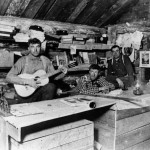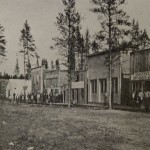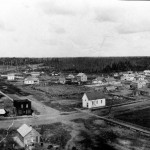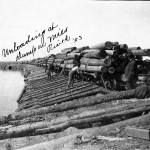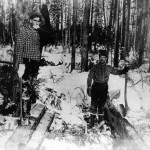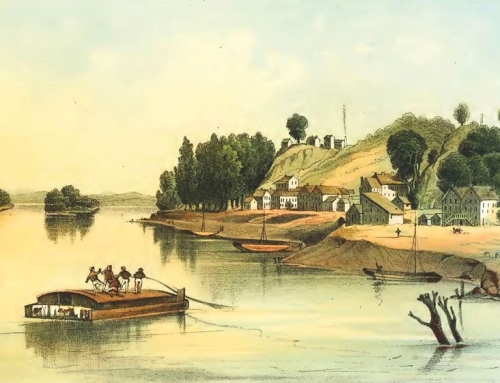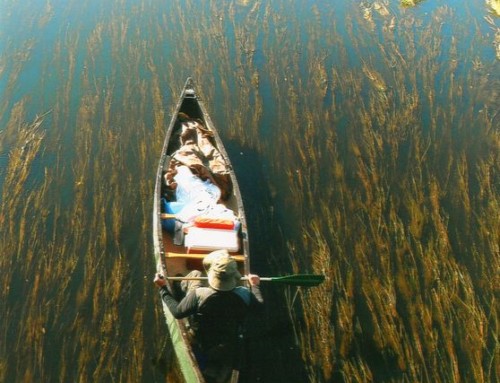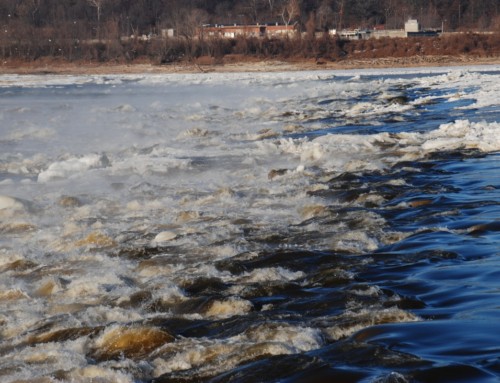I’m working on a new book for 2012. Unlike my other Mississippi River books, this one will not be a travel guide but a collection of stories about the people and places of the Mississippi River. I’m big on putting the river in its broader context, so the chapters in this new book will often zoom out to include stories about the general area through which the river flows. Because of that, I spent a lot of my time in northern Minnesota last summer exploring forests, iron mines, and lakes, even if they weren’t right next to the Mississippi.
I’ll have more to say about the new book down the road, but for now I thought I’d share a draft of the chapter I’m writing on the logging industry in northern Minnesota. Let me know what you think.
Chapter 5: Forests Old and New I first hiked the Bohall Trail in Itasca State Park in August 2011, guided by Naturalist Connie Cox, whose broad knowledge of the landscape spills out in a stream-of-consciousness monologue as we hike. The trail winds and undulates through a forest dense enough to hide a bear or a wolf just a few yards from where we hike. Dappled sunlight penetrates to the forest floor feeding large-leaved aster, beaked hazelnut, and broken ferns. The ground is covered by pine needles. Every step releases a fresh burst of their scent. The forest is dominated by white and red pine, centuries-old trees with tufts at the top that reach one hundred feet high. Bogs and shallow lakes break up the density, revealing a wider view of the forest, as well as launching pads for thick clouds of mosquitoes and aggressive deer flies. As we get close to the bog, the firm topsoil gives way to a spongy surface of peat that might tolerate the weight of one average person (average by 19th century standards, anyway) but two people standing in the same spot will sink in the muck two or three feet deep, each step a laborious effort of raising their feet up and out and into the next spot of thick mud. If they are less lucky, they will get trapped by the viscous suction and need a hand or two to get on their way again. This is essentially what Minnesota’s pine forest was like before logging began. There are few places left in Minnesota where you can experience it. In 1870, dense forests of old red and white pine and swamps of spongy peat covered the northern third of Minnesota from Lake Superior to the Dakotas. While cities along the Mississippi River further south were booming—in the previous decade, the populations of St. Louis and Memphis had doubled while New Orleans continued its steady growth—around the Headwaters of the Mississippi River in northern Minnesota wolves still outnumbered people. Few Europeans had moved into the area and most Ojibwe had been moved to reservations at places like Red Lake and White Earth. By 1890, just twenty years later, towns like Deer River, Grand Rapids, and Bemidji had been carved out of the forests and built atop the swamps and 20,000 men lived and worked in logging camps. Twenty years after that, the great pine forests were essentially gone, leveled to feed a relentless appetite for wood as the US expanded west. Miles of towering pines were replaced by a barren landscape of stumps and debris that spread across the horizon, providing kindling for massive fires that occasionally erupted, sweeping away the debris, along with towns and people. Just one of these, the Cloquet Fire of 1918, burned across 1,500 square miles southwest of Duluth, destroying ten towns and killing 453 people. As the trees disappeared, the logging companies moved further west to harvest more trees, eventually to Washington and Oregon, taking all they could with little forethought, expecting that the lands they left behind would be cleared for farming. Some of the denuded land in Minnesota was cultivated for agriculture, often sold on the cheap to former loggers. Before the land could be farmed, the stumps had to be cleared, sometimes with backbreaking labor, sometimes with back-saving dynamite. Early farmers had some success with root vegetables like potatoes and rutabagas, but farming in northern Minnesota was not the path to wealth: the soil was often sandy and the growing season short, just 120 days on average from the last frost in mid-May to the first frost in mid-September. In places where no attempts were made to farm, the forests began to regenerate. Aspen and birch were the first to reestablish, followed by white spruce, then oak, then maple, basswood, and ironwood, before white pine slowly reemerged. If left alone, the pine forests could fully recover in a couple of centuries. But we don’t leave them alone. We still need wood. Folks began to figure out other models for logging that ensured a more consistent harvest without devastating the landscape. Tax-forfeited land entered public trusts. Land was surveyed to catalog the amount and type of trees that had regenerated or been replanted. Land management rules were established that allowed only a percentage of the available trees to be logged in any given year. Remaining stands of old growth forest were protected in places like the Lost Forty and at Itasca State Park. Today, trees grow faster than they are being cut, and the few forests that we have left alone are slowly regenerating. Logging today is still central to the economy of northern Minnesota; there aren’t a lot of other options. Many small landowners make much-needed extra cash by selling their trees, and a few communities still have small mills that provide jobs, like the paper mills in Grand Rapids and International Falls. In today’s forests, the mature trees are mostly aspen, balsam fir, and spruce, trees that are useful for pulpwood to make paper and wafer board to make cheap furniture—disposable products for a throw-away society. The white and red pine that once dominated northern Minnesota’s forests, prized for their strength and permanence, are now the exception. And that’s the quick version of the story. There is a lot of romanticism associated with those logging days, some justified, some not. We devastated a landscape that developed over millennia to satisfy short-term economic needs. Logging companies often used unscrupulous practices to acquire land or the rights to harvest it. Loggers were tough, independent men who worked hard and lived even harder. And the towns that grew up to supply the camps were not places for the genteel; they were isolated, often dangerous, with a beauty that mirrored their clientele. Here are some of their stories. The logging companies came for the gorgeous white and red pine. Red pine has scaly bark with a reddish-brown tone, two needles per bunch, and can reach a hundred feet in height. White pine grow taller, as tall as 200 feet, have five needles per bunch, deeply ridged bark, and their tufts often reach high above other trees. Both trees can live for centuries. Red pine favored drier sites that burned frequently; white pine, in contrast, preferred sites with more moisture and less intense fires. Pine was soft, easy to cut, and floated well, yet remained durable and resistant to rot. White pine was especially desirable; it grew straight and strong, making it easy to process and easy to build with. The growing US West had a nearly insatiable appetite for wood, for building houses, stores, and railroad tracks, and as a fuel source, at least until coal became more widely used. Without wood, the growth in the West would have been far slower. Wood from the pine forests of Wisconsin and Minnesota met much of this demand, building towns like Minneapolis, Fargo, Omaha, even St. Louis. The first sawmill in Minnesota was built in 1821 by the US government to supply Fort Snelling, but the state’s logging industry really began in 1837 along the St. Croix River and worked its way north and west. Before land had been fully surveyed, interlopers would take down sections before anyone could stop them. “Guys came down from Canada along the Big Fork River and would cut down trees (illegally),” said Bill Marshall, the Dean of Forests and former Land Commissioner for Itasca County. The remote area was difficult for government officials to reach in the 19th century. “It takes them weeks to get here and then when they get here they don’t know where they are.” Logging was a seasonal activity. Trees were cut down in winter, which might seem like an odd time of year to be living and working outside in northern Minnesota. But, northern Minnesota has a lot of water—lakes, swamps, bogs, creeks—that, in the 19th century, made getting from place to place slow and unpleasant. In the winter, all that water is frozen, so getting around is much easier, whether on foot or by sleigh, plus the woods are free of mosquitoes, ticks, and deer flies, which is a nice bonus. Thousands of men worked in logging camps. They generally reached the camps, or the nearest town, by train, with their employer covering the cost of the fare. This might seem like an act of generosity. It wasn’t. The company would deduct the cost of the ticket from the worker’s pay in the spring, along with the cost of purchases from the company store and any other accrued debts. In the camps, men lived in communal housing—large, single-roomed log cabins, really—filled with dozens of bunks in long rows stacked two high. Each bunk was cushioned with a straw mattress and slept at least two men. You stayed warmer that way. Your clothing sack, sometimes called a turkey, was your pillow. In the middle of the room sat a wood-burning stove. If it was your job to keep the stove burning, you could count on a night of irregular sleep as you awoke at regular intervals to feed the stove throughout the night. The company had a store on site with a few supplies. One of the favorite items was canned tomatoes, which the guys would open and drink as a snack. No whiskey was allowed in camp; you had to go to town for that. Evening entertainment might be playing music or card games or maybe sharpening your tools; bedtime was often before nine during the week. The men had to wash their own clothes; living quarters were decorated with drying underwear and socks hanging from the beams instead of landscape paintings purchased from starving artists. If their clothes froze overnight, which they often did, the men could warm them by the stove before dressing in the morning. A heavy wool jacket called a mackinaw was the most important item in their wardrobe, essential for shielding the men from the subzero temperatures they often worked in. Most every day followed the same pattern, a routine that logger George Austin Woodward described as “a dull routine of toil.” Daylight was in short supply in the winter, with sunrise around 8am and sunset just eight hours later. To make the most of the limited daylight, men awoke well before sunrise to dress, eat breakfast, and travel to wherever they were cutting that day. Breakfast and dinner were eaten family style, served on tin plates and mugs, in a large mess hall, consumed quickly and quietly except for the sound of clanking iron knives and forks. The food was plentiful and hearty but predictable; pork and beans were often served three times a day. Other choices might include cheese, beef, liver, sausage, bologna, peanuts in the shell, ham, salt pork, and bacon. Some meals, like lunch, had to be served outside; in mid-winter, the beans might freeze on your fork before they reached your mouth. Cooks worked long hours, but it wasn’t a bad job. One bull cook, who was just 15 years old, said he worked 18 hours a day for just $7 a month, yet he felt well-off. The camp needed a lot of men (upwards of 200 could be at any given camp) to fill a lot of different jobs. Handymen and blacksmiths kept the camp supplied with all the right tools. Undercutters or choppers were skilled axemen who made notches in trees to direct their fall. Sawyers used a two-man cross-cut saw to complete the fall. Undercutters then marked standard lengths on the tree, usually from 12 to 18 feet, and sawyers cut some more. Swampers trimmed the branches off the trees and cleared brush so the logs could be dragged by a team of two horses to rollways that ran parallel to the logging road. Top loaders piled the logs onto sleighs using a horse to pull from the front end while jimmying it up a ramp from the back end. Each sleigh could have several tons of timber on it as it skated across an ice road that could be as much as two feet thick. Road monkeys built and maintained the ice roads, pouring water over them at night to create a fresh slick surface and sweeping them free of debris and manure during the day. Draft horses pulled the sleighs to holding areas, usually a frozen lake or river where they would be stored until spring. Inlets and outlets of lakes were usually dammed so water levels would remain predictably high. Camp foremen kept an eye on the whole operation. The camp shut down when the ice went out. Men got paid, then headed to town to spend it in the saloons. In the early years, lumberjacks were paid $16-$18 a month; by the turn of the century, the best loggers earned $40 a month or slightly more than the average US worker. Loggers were often easy to separate from their money, especially in the saloons, so some companies started paying just $10 at the end of camp and made the men go to Duluth or Minneapolis to collect the balance. Other companies issued “time checks” that could only be cashed at a future time or in a different city. In spite of these precautions, local merchants, bankers, and even the logging companies devised schemes to allow loggers to cash the checks in return for a commission of nearly 25%, a practice that was called “shaving.”The Minnesota legislature eventually outlawed the practice. Loggers were men who worked hard, spent like they worked, and lived like they spent. Most didn’t bank any money until they left logging for some other occupation. As the loggers broke camp, they left behind huge piles of cut timber in area waters. At Cohasset, logs often piled so thick on the Mississippi River that you could walk across them without getting wet. It was the job of the river rats to move these piles out of storage and to the sawmills by driving them downriver. Even with the men working from sunrise to sunset, it could take several weeks to drive logs down the Mississippi River from Grand Rapids to Minneapolis as river rats maneuvered through a narrow channel and around meanders; log jams were common. Meals were served from a wanagan, a houseboat that served as a kitchen and dining room (and a bunk for some men), and consisted of delicacies like cold storage eggs, salt pork, and boiling beans (more beans!). Log drives were hard work, but river rats were among the best paid workers in the logging trades. Logging of Minnesota’s white pine peaked in 1900 when 2.3 billion board feet of lumber were processed, enough to build 600,000 two-story homes. Production stayed at that level for about ten more years then rapidly declined. The last log drive down the Mississippi River was in 1918, forcing many communities to retool their economies. The towns that sprang up around the logging camps were cut right out of the forest. In 1872, H.L. Bridgeman visited two-year old Brainerd and described the main street as “…a long row of everlasting wooden fronts, peculiar to western railroad towns, and hiding cheaper and poorer structures behind.” Many of the towns began as supply points for the logging camps, providing necessities like food, clothing, alcohol, and sex. Aitkin was one of those places. When it sprang to life in 1871, it was the northern-most settlement on the Mississippi River. Most of the 2000 men who worked in nearby logging camps arrived via the Northern Pacific Railroad to the Mud River station, then overnighted at the home of James Warren Tibbets, the area’s sheriff, before walking the rest of the way to camp. If the men had a little leisure time, they could have a drink at one (or more) of the town’s 17 saloons. Brainerd’s Main Street was a motley collection of saloons and gambling halls. One of these places, the Dolly Varden club, had a whitewashed interior and a sawdust floor. The first room as you entered was roughly 40 feet deep by 20 feet wide and was filled with gaming tables. On each table a cotton rag with lettering in red paint was hung to announce the type of game: chuck-a-luck, high dice, mustang. To play higher class games like rouge-et-noir and faro, patrons had to go to the back room. This establishment, unlike most, did not serve alcohol, which is probably why its patrons were described as quiet and well-behaved. One would never have described the crowds at Deer River’s saloons as quiet and well-behaved, however. During the logging era, people called Deer River “a hole in the swamp” or the “longest whiskey row in the state.” The main street was muddy in spring, dusty in summer, and covered by drifting snow in winter. The saloons—arranged along a lengthy boardwalk elevated about a foot above the swampy terrain— never closed, not even after major fires. After a blaze in 1898 leveled most of Deer River, saloon owners quickly put up tents and continued to serve customers until their new buildings were completed. When it came time to order, you didn’t have many choices. You could buy a mug of beer for 5 cents but your only choice was a beer called Moose; a shot of whiskey was 10 cents. If you were really thirsty, you could buy a 10-quart pail of beer to sate your desire. On a night out, card players might include Mushhead Collins, Sore Eyed Johnson, Winnipeg Blacky, Crosshaul Slim, Pig Eyed Kelly, or Larry the Brute. According to legend another local character, Hungry Mike Sullivan, once had a very large tapeworm removed from his body. There weren’t many women around and their company usually came with a price. The local newspaper referred to these ladies of the evening as “fairies of easy virtue.” Loggers might hook up with Box Car Nell, Three Fingered Maude (whose services were discounted 40%) or Dora the Mule. The inevitable conflicts that arose were often resolved without much deliberation. Bull Collins gave his money to bartender Jack Jones for safe keeping. When Collins returned, Jones denied that he had ever been given the cash. Collins didn’t like this answer, so he returned with a gun and shot Jones, or at least he thought he did. He actually killed a man known as Jack the Horse, a different bartender who was as big as Jones and looked a lot like him. Collins was arrested and convicted for the murder but only served three years in prison. I don’t want to give the impression that people were routinely shooting each other in Deer River, but they were. Charlie Grant was suspected of burning down one of the town’s saloons. Patty Burke was chosen to administer some local justice, which he did by shooting Grant. After Grant fell to the ground, dead, a bystander decided he could use a souvenir, so he took Grant’s watch from his corpse. Burke went free but the guy who stole the watch got 20 years in prison. At least he’d always know the time. Eventually all those old logging towns grew into respectable places to live. Murder is no longer a common way to resolve disputes. Churches were built; many people moved on, so the towns got smaller; those who remained found something else to do. Deer River today no longer has boardwalks, but it still has quite a few saloons, not one of which is housed in a tent. The saloons are now more likely to be overrun with fishermen than loggers. Logging camps may be a thing of the past, but Deer River still has a lumber industry that employs a few people. The Rajala Lumber Company, founded in 1910 by Ivar Rajala, is now run by the fourth generation of Rajalas. You can still gamble, too. Deer River has the White Oak Casino, operated by the Leech Lake Band of Ojibwe. And Deer River is still surrounded by forests—the town is just south and east of the Chippewa National Forest— and has field offices for the Minnesota Department of Natural Resources and the US Forest Service. Two months before I hiked the Bohall Trail at Itasca State Park, I explored part of the Chippewa National Forest with a seven-mile hike to the Joyce Estate, the one-time summer escape for David Joyce, heir to the family that made part of its fortune by logging these same forests. The trail follows an old service road, a wide path with few obstructions along relatively flat terrain. The forest is mostly aspen, birch, and spruce; I didn’t see much pine. If I had wandered off the main path, I could have lost a boot in the muck of a peat bog. Deer, bear, and other wildlife have returned, and the bogs and lakes are still good breeding grounds for gazillions of mosquitoes. On this Saturday in early June, thousands of dragonflies were out, dancing and buzzing around me. I reached the remains of the Joyce resort in early afternoon; the air temperature was in the low 70s—the first warm day of the summer—and the bright sun made it feel even warmer. After exploring the empty buildings and ensuring that I had the place to myself, I found a small beach, stripped off my clothes, and took a brief dip in the brisk water. I passed fewer than half a dozen people all day, including the two men camped on the edge of impossibly blue Trout Lake. Chippewa National Forest has dozens of miles of developed trails, some approved for mountain biking, some for all-terrain vehicles and snowmobiles. The Forest Service manages several campgrounds and built a few simple campsites in remote areas. And logging continues, even in the national forest. Each year some 64 million board feet of lumber are cut from Chippewa National Forest. This is our 21st century forest. © Dean Klinkenberg, 2012
